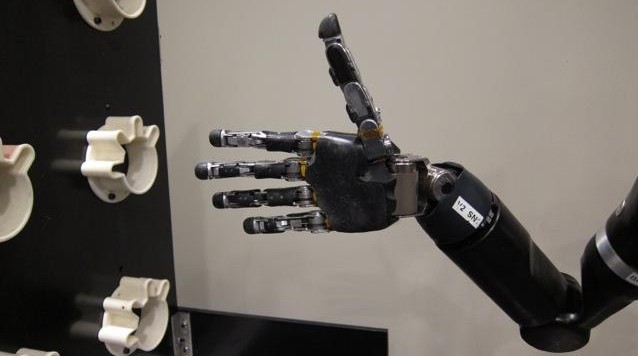
A new prototype mind-controlled robotic arm is the latest example of brain-computer interface technology being developed with the ultimate aim of improving the quality of life of people unable to use their own arms.
We recently reported on robotic prosthetic arms for amputees. Those prosthetic limbs can be controlled by the users and also deliver a sense of touch. Now, a woman with quadriplegia has been able to remotely move a robot arm with signals from her brain. She has even been able to use the mind-controlled robotic arm to pick up and move objects.
The woman who got to test the new mind-controlled robotic arm is Jan Scheuermann. Before she could use the arm, she needed to be connected to electrodes with 96 tiny contact points. These were surgically implanted in the regions of Scheuermann’s brain that would normally control her right arm and hand movement.
This project is the work of researchers at the University of Pittsburgh School of Medicine. “Our project has shown that we can interpret signals from neurons with a simple computer algorithm to generate sophisticated, fluid movements that allow the user to interact with the environment,” said senior investigator Jennifer Collinger of the Department of Physical Medicine and Rehabilitation (PM&R), Pitt School of Medicine, and research scientist for the VA Pittsburgh Healthcare System.
Within a week of the surgery, Ms. Scheuermann could use the arm to reach in and out, left and right, and up and down to achieve 3D control. Before three months had passed, she could also flex the wrist back and forth, move it from side to side and rotate it clockwise and counter-clockwise, as well as grip objects.
How did the mind-controlled robotic arm work?
When Scheuermann thought about a movement, the electrodes picked up signals from the neurons in her brain. Those signals were then relayed to a computer to identify the firing patterns associated with particular observed or imagined movements, such as raising or lowering the arm, or turning the wrist. That “mind-reading” capability was used to direct the movements of the robotic arm, which was developed by Johns Hopkins Applied Physics Laboratory.
“Overall, our results indicate that highly coordinated, natural movement can be restored to people whose arms and hands are paralyzed,” says Andrew Schwartz, Ph.D., professor of Neurobiology, Pitt School of Medicine.
Related: Researchers Create Flexible, Printable LED
In Conclusion
After the study was complete, doctors removed the electrodes from Scheuermann’s brain, concluding her successful participation in the study. “This has been a fantastic, thrilling, wild ride, and I am so glad I’ve done this,” she says of the experience. “This study has enriched my life, given me new friends and coworkers, helped me contribute to research and taken my breath away.”
The research team included John E. Downey, BS, Elizabeth Tyler-Kabara, M.D., Ph.D., and Michael Boninger, M.D., all of the University of Pittsburgh School of Medicine; and Brian Wodlinger, Ph.D., now of Imagistx, Inc. The project was funded by the Defense Advanced Research Projects Agency, the Department of Veterans Affairs, and the UPMC Rehabilitation Institute. The results of the study are published in the Journal of Neural Engineering.




